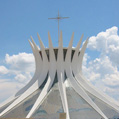PAST EXHIBITION

Oscar Niemeyer
Architect Oscar Niemeyer, Designer of Brasilia: Celebrating his 100th Birthday
September 10, 2008 – October 26, 2008
ABOUT THE EXHIBIT
Regarded as one of the major contributors to the development of modern architecture, Oscar Niemeyer has produced roughly 700 public works in his homeland of Brazil and abroad. He is best known for designing the city of Brasilia, and for his dream-team collaboration with Le Corbusier for the United Nations building in New York.
In addition to being still actively working –as well as getting married in 2006 at the age of 98, Niemeyer has recently designed a stadium for the 2014 World Cup Soccer Championships that will be hosted by Brazil. The Oscar Niemeyer exhibit features original plans and sketches, video and photography footage, scale models of major projects, and timelines of Niemeyer’s life and career.
Born in Rio de Janeiro in 1907, Niemeyer grew up as a carefree bohemian youth before marriage at the age of twenty-one grounded him into a sense of interest in his future, driving him to enter University. Upon completing his degree in architectural engineering from the Escola de Belas Artes in Rio, he took notice of his surroundings and a desire to inject new life into the streets and buildings began to fuel his early works.
It was in 1940 that Niemeyer was commissioned to design a new suburb to the north of the city of Belo Horizonte. The result was Pampulha. Its curves and straight lines interplaying with elements of rationalism converged with free-form and organic influences. The Pampulha complex is widely regarded as the birthplace of modern Brazilian architecture. In the late 1940s, Niemeyer traveled to the United States to take part in the design of the United Nations Headquarters in New York. The board of ten design consultants ultimately chose the collaboration between Niemeyer and Swiss architect and planner Le Corbusier, as the basis for the building’s final design. The 1950s saw his continued influence by European surrealist landscapes, sculptor Jean Arp, and the sensuousness of Brazilian women. He began to incorporate reinforced concrete in order to strengthen his free-form designs. Sao Paulo’s Ibirapuera Park Complex, replete with lively and inspired structures from its museum to its planetarium, displays Niemeyer’s visions for people to enjoy in their moments of leisure and exercise.
Later that decade, he designed the Museum of Modern Art of Caracas, Venezuela. Beginning in 1956, a new capital city for Brazil was planned. Brasilia would be laid out by master urban planner Lúcio Costa, and its buildings would be designed by Niemeyer. In a few months, Neimeyer designed the Presidential residence, the Senate and Congress Buildings and the Cathedral, as well as other residential buildings. Brasilia was completed and officially inaugurated in 1960. Seen from above, its buildings all contain common elements, giving the city a unified appearance while at the same time each of its structures radiate uniqueness. Conceived and completed within four years, Brasilia tested new concepts in urban planning. For instance, Niemeyer designed many buildings to float freely from the ground, allowing the space underneath to coalesce with nature.
Throughout his storied career, Niemeyer has not wavered in his efforts to diminish social injustice, routinely waiving his fees for causes in which he believes. He has planned model schools for the benefit of public school students in Brazil, and designed a convention center for the Landless Workers' Movement in the northeastern city of Fortaleza. His struggle for a better and fairer world continues to inspire his work and to move those who experience it.
Niemeyer has worked unceasingly and prolifically up to the present day. In 1996, at the age of eighty-nine, he designed the Niterói Contemporary Art Museum near Rio de Janeiro. Set at the side of a cliff along a beach, the museum resembles a UFO, is one of Rio’s primary landmarks, and is often heralded as Niemeyer’s greatest work.
FEATURED ARTIST
Oscar Niemeyer

